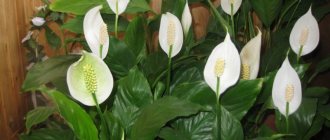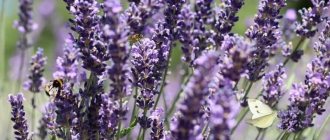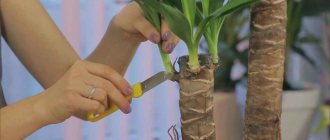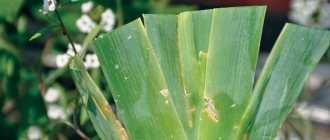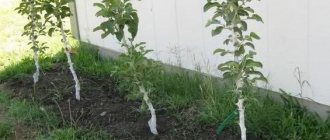Why is pruning needed?
Pruning allows you to give the flower a beautiful shape. A young plant looks good in a pot, but as it grows, it stretches out and lacks splendor: the trunk is thin, there are few green leaves. Therefore, the top is cut off and the branching process is started in a similar way. The crown becomes richer, and the flower itself looks more alive.
Yucca grows quickly; at home, the root system cannot always provide the crown with moisture and nutrients - when the stem is shortened, this problem disappears.
If the plant begins to die, then pruning is also carried out. This is how cuttings are obtained from which new specimens will grow. If the trunk has rotted, it is often possible to save the tops, which are used for further rooting.
Another reason for pruning is trunk curvature. A bent stem can break, which is very painful for yucca. In addition, there is a risk that the pot will simply fall under the weight of the leaves. Therefore, it is better to cut off the crooked trunk and allow the flower to grow new shoots.
The plant is also pruned if it is damaged by a pest or fungus. More often this happens with yucca growing in open ground. In order to save the flower, all its damaged parts are removed and the plant is treated with chemicals. Leaves that have been cut are immediately disposed of so that the pest does not spread throughout the garden.
Why prune yucca
Yucca is a false palm.
It has a woody trunk, at the top of which there is a rosette of long and narrow leaves. If you do not form a crown, the shoot begins to grow in height and can reach impressive sizes. There will be a single rosette at its top, and the plant will not have a decorative appearance. The only way to make yucca more fluffy and dense is to regularly trim the shoots. In such conditions they begin to branch, and the tree can be given any shape. The formation of the yucca trunk is carried out to stimulate the growth of new shoots. Each of them will have a rosette of leaves, and together they will be able to form a thick and lush crown. In addition, trunks that grow in length gradually become insufficiently strong and can be damaged under their own weight. A properly formed home yucca looks like a small and compact bush covered with greenery.
The tops of the yucca trunks should be located at the same height. If a side shoot begins to grow at its base, partial pruning is also necessary to level the crown.
When is the best time to prune yucca?
The ideal time is from the end of winter to the beginning of spring, that is, February-March . The daylight hours are lengthening at this time, but the sun is not yet burning. Yucca begins to wake up after winter dormancy, so it will be good to move away after pruning, drying the sections normally. After they are “sealed”, the yucca will begin to actively branch.
By the way! If your yucca overwintered correctly (that is, from November to February you kept it in a room with 10 degrees), it will tolerate pruning and growing new roots and leaves best.
It is important to complete the work before April . This month the plant is already starting to actively grow. That is, juices move along the trunk with redoubled force. If you halve it in mid-spring or later, the cuts will not dry out, the yucca will “bleed” for a long time and may even die.
Of course, you can prune yucca in other seasons, not only in spring. But the plant germinates faster in the spring and also grows better, so many people choose this time.
How often can you prune yucca?
It is better to touch a young (recently purchased or grown) plant after two years . Before, it simply doesn’t make sense - the stem won’t have time to stretch out yet.
If the plant has several shoots at the same time, one or two can be cut off for propagation. But do not remove everything at once, this can greatly weaken the mother plant. It is optimal to remove a shoot (shoot) from a mature yucca per year.
If the plant has been flooded for a long time and its rhizome or trunk has begun to rot and become soft, you don’t have to look at the frequency or time of year. Remove the top of the yucca immediately. This may be your only chance to save the plant. It is advisable to cut off the “cap” (and stem shoots, if there are healthy places without dark, putrefactive spots) to a length of 10 to 15 cm. In addition, if the root seems healthy to you, it, along with the exposed small stump, can be transferred to a fresh substrate.
Yucca varieties
The family includes more than 40 species, but only 10 of them can be grown in our territories. There is a division that depends on the presence or absence of a stem. The most popular types of yucca:
- Elephant. People call it elephant because the trunk is similar to the leg of this animal. The elephant yucca has numerous shoots at the top with leaves that are arranged very tightly.
- Short-leaved. This species is also called tree-like or giant. It grows naturally in southeastern California and Arizona. Yucca shortifolia is a tree that reaches a length of 4-9 m. The leaves are short, hard and densely spaced.
- Filamentosis. This species has a very small trunk, so it is also considered stemless. Yucca filamentosa is suitable for growing in our areas because it tolerates frost. The leaves are gray-green in color and have a very sharp end, and there are a large number of thread fibers on the edges.
- Gray. A popular type of shrub that has a small stem. The leaves have thin and curled threads. The peduncle has racemose inflorescences with bell-shaped flowers. Yucca glaucosa grows in the western part of America.
- Aloe leaf. The species is represented either by a spherical bush or a small tree whose height reaches 8 m. Adult plants have many branches, at the ends of which there are dense rosettes of fibrous leaves. Yucca aloelia has a prickly thorn on the edge of its leaves.
Pruning Recommendations
Professional recommendations:
- Before trimming the yucca after flowering, it is worth watering it abundantly (2 days before the planned procedure).
- The plant should be trimmed with a very sharp knife or pruning shears, having previously disinfected the tool.
- Cutting should be done in one motion. Under no circumstances should you “undercut and break off.”
- After the procedure, dry the wound in the open air and fill it with liquid paraffin.
Inventory
You should prepare the necessary equipment in advance:
- pruning shears or sharp knife;
- alcohol;
- paraffin or any garden putty;
- anti-stress drugs for plants, for example, "Epin";
- Activated carbon;
- drainage, soil and container for rooting the cut top.
Sanitary pruning
The appearance of a large number of dry branches and yellow leaves requires the gardener to carry out special procedures, the purpose of which is to improve the health of the plant. To do this, all damaged branches are completely cut off. The work requires care so as not to damage the plant trunk.
In case of strong thickening, the lower tier of leaves is cut off. The flowering of yucca is accompanied by the release of a powerful peduncle, which, rising above the foliage, reveals many small inflorescences. They can be white, green or beige. When the process is complete, it must be carefully cut off.
Trimming methods - step by step trimming
The procedure is carried out carefully. You can significantly reduce stress for a flower if you strictly follow the step-by-step instructions.
- Determine the location of the cut. The length of the stump should be between 25–50 cm; this size is sufficient for the formation of young shoots.
- Hold the crown with your hand and make a cut. This must be done clearly, in one movement, completely cutting off the trunk and preventing it from breaking off. If the stem is broken, the plant's vascular system will be disrupted.
- The cut area should dry naturally. To do this, leave the plant alone for 2 hours.
- Treat the cut with garden putty or paraffin. This will protect the yucca from moisture loss and create a barrier against the penetration of harmful bacteria.
Before starting the process, try to imagine the appearance of the plant after the manipulation. Please note that after pruning, the palm tree stops growing the main trunk, its thickness also remains the same, only newly formed shoots grow. Therefore, the plant is formed when it reaches a certain length of 50-70 cm.
Yucca with several trunks
If there are several shoots, pruning is carried out in several stages: along the trunk for a year. Given the slow growth of yucca, they will develop evenly.
Important! If all trunks are manipulated at the same time, the plant may die from stress.
How to prune yucca after flowering
At home, yucca rarely blooms. But if you create favorable conditions for it, beautiful white flowers that look like bells may appear in the summer. For this to happen, the plant needs a lot of light, good feeding and rest in winter. Before blooming, the yucca throws out an arrow, on which buds are formed.
After flowering, a bare stem remains, which does not look very aesthetically pleasing and spoils the appearance of the plant. Therefore, when the last petals fly off and the peduncle itself begins to dry, it can be cut off. This is done with sharp pruning shears at a slight angle to the very base. Also remove the lower line of leaves, which usually wilt and turn yellow.
How to trim yucca to produce side shoots
Annual pruning of yucca shoots allows you to adjust the shape of the trunk and its branching. An unusual indoor tree will fit perfectly into the composition in the interior of an apartment or office, taking a central place in it. Ficus benjamina, spathiphyllum, zamioculcas or money tree will look great against the background of a palm tree.
Experts obtain really interesting and non-standard bends of a palm tree while the plant has not yet completely lignified. In order for the trunk to stretch in length, the pot with the plant is placed where it will experience some light deficiency. In an effort to receive more sunlight, the palm tree will grow a trunk, and then it will be possible to give it an unusual position.
How to prune yucca for branching
A gardener who has yucca grown after cutting an adult plant will sooner or later have to learn how to prune yucca at home. To obtain a palm tree with a spreading crown, you need to root the most powerful of the tops obtained during pruning.
The pruning procedure is often carried out for further active branching of the palm tree. If you want to get a more magnificent yucca, then it is advisable to wait until its trunk becomes thicker than 5 cm. Then the likelihood of more young shoots appearing at the top of the trunk increases. In addition, the central stump must be strong enough to support several overgrown crowns.
Timing of pruning
Beginners are interested in how to prune yucca at home, so that after the procedure it produces 2-3 beautiful shoots with a gorgeous rosette.
How to prune yucca correctly? To hold the event, you should choose the end of the winter dormancy period. This is the end of winter or the beginning of spring. The exotic plant is pruned before intensive movement of sap begins.
Already in mid-spring, as soon as the sun warms up, the growing season of the crop becomes more active. The procedure at this time can lead to the death of the exotic pet. If the plant is pruned before the beginning of the growing season, then the cut has time to drag on and new growths will form. The capricious yucca, whose trunk is trimmed correctly, will delight you with beautiful branches this summer.
Important ! The yucca should be trimmed when the thickness of the trunk becomes more than 5 cm, since after the “operation” it will stop growing in diameter.
How to prune indoor yucca
Pruning indoor yucca is a simple procedure. It is carried out according to the following algorithm:
- choose a cutting location using only a strong and wide trunk;
- holding the plant by the leaves, run a knife or pruner along the shoot - it is important that the shoot is completely separated the first time;
- treat the cut with paraffin, activated carbon or any purchased product;
The basic rule for trimming yucca is to avoid breaking the stem. It should separate immediately, with the first movement of the knife or scissors - this is the only way the harm to the palm tree will be minimal.
If part of the trunk is cut off with scissors that are not too sharp, and then it breaks, the plant will take a long time to recover and may even die. It is also important not to forget that pruning is carried out to form new branches, so the trunk should easily withstand 2-3 new full-fledged shoots with rosettes of leaves. Whether it is possible to trim the leaves of a yucca depends on the purpose of the procedure. Only shoots are suitable for cuttings and crown formation, and it is better to leave the green part on the tops.
Reasons for pruning
Yucca is a false palm. In most cases, if the crown is made up of a single rosette of sword-shaped leaves formed by the top of the trunk, the plant does not look very presentable. Indeed, a thin, elongated (up to 2.5 m) stem with a patch of leaves near the ceiling is a depressing sight.
The florist begins to look for ways to increase the diameter of the crown and its density. The decorative and aesthetic appearance of a false palm tree can only be achieved by pruning . This effective measure forces the yucca to branch, turning the palm tree into an exotic bush.
Sometimes in practice a different situation arises - the plant unexpectedly produces a lateral sprout. Moreover, for some reason the bud wakes up at the base of the trunk. The large difference in height between the crowns also does not look very attractive. There is only one way out - partially cut off the stem.
How to prune garden yucca
The main pruning of garden forms of plants is carried out similarly to the procedure with indoor ones. The only difference is the size. Since plant growth is not limited by the size of the room, it can be adjusted at your discretion. In addition, yuccas in open ground require constant sanitary and therapeutic pruning. They are carried out in the fall before sheltering for the winter and in the spring after emerging from dormancy.
- The autumn procedure is carried out 3-4 weeks before the upcoming frost. At this time, all old and weakened shoots are cut off and flower stalks are removed.
- The remaining leaves are treated with fungicides and tied into a bundle. The trunk circle is mulched with a dense layer of peat, and the plant is covered with spruce branches.
- In the spring, after removing the shelter for the winter, the yucca is carefully inspected. At the same time, frostbitten, rotten and yellowed leaves are cut off.
- 7 days after this, the plant can be treated with fungicides.
Pruning may also be necessary in case of mass infestation by pests or fungal diseases. In these cases, all affected areas are radically cut off, followed by disposal of plant waste. The plant is treated with chemicals, which are selected depending on the damage.
Pruning garden yucca
In principle, there are no special differences from pruning an indoor specimen. The main difference is that the procedure is carried out twice, like with most garden plants. In spring, frozen, diseased shoots and foliage are removed.
Formative pruning repeats the procedure for indoor yucca, only a larger number of buds remain. The sections are treated with garden varnish or grafting wax.
You can prepare the product yourself:
- Buy “Ozokerit” (an anti-inflammatory drug) at the pharmacy.
- Melt both substances, taken in equal proportions, in a water bath.
- Mix well.
- The drug is applied to the cuts as a fungicide.
Important! Remote areas of the plant with rotten areas should be burned so as not to spread the infection.
1-1.5 months before the onset of the first frost, the yucca is inspected and damaged or diseased leaves and dry flower stalks are removed. The sections are disinfected. As soon as the cuts have dried and healed, you can cover the palm tree for the winter.
What to do after pruning
Having completed the pruning, the plant is given rest by leaving it at normal room temperature, but moving it to a darker place. During this period, direct sunlight can greatly harm the palm tree and even destroy it. It is advisable to postpone the first watering for 5-7 days. It is better to use water that is warm enough, not lower than 20-25 °C.
Under such conditions, young shoots appear on trimmed yucca after 4-6 weeks. New buds hatch just below the cut. If the trunk diameter is more than 5 cm, it is recommended to leave 2 or 3 shoots from opposite sides of the stump for germination, and remove the rest with a sharp, disinfected instrument.
Advice! For more powerful plants, you can leave up to 4-5 new bunches of leaves, from which a lush spreading crown is later formed.
After pruning, the yucca is provided with the following simple care, thanks to which it will recover easier and faster:
- Regular, not frequent watering is carried out - once a month.
- Ensure that you stay in a well-lit place.
- Starting from June and until autumn, when young palm shoots begin to actively grow, complex fertilizers are applied (once a month is enough).
Yucca is unpretentious and tolerates pruning without problems. A correctly formed palm tree will look gorgeous in the interior, especially in a large space of a private home, in the office hallway or in the living room. Elongated leaves of rich green color will fill the room with fresh tropical exoticism.
Recommendations from flower growers
Beginners in floriculture often make mistakes that lead to dire consequences.
Advice from experienced plant growers will help you avoid them:
- For successful pruning, it is advisable to allow the plant to grow a trunk diameter of at least 5 cm.
- Outdoor specimens are pruned in warm, windless and dry weather.
- More than 5 buds left on the stump can create an overload for the yucca.
- During the dormant period, the pot is transferred to a cool room up to +15°C.
- Close proximity to operating heating appliances is not allowed.
- When watering, you need to focus on the speed of drying of the soil; overwatering is destructive.
- It is imperative to disinfect working tools, soil, containers and flower cuts, otherwise disease cannot be avoided.
GRAFTING WAX FOR SEALING
WHAT IS GRAFTING WAX?
Grafting wax is used to heal cuttings during grafting and pruning of trees. It is also used in the private sector and for agricultural fruit growing. High quality grafting wax is created using a fungicidal resin and a combination of wax. It can be applied with a spatula or knife.
Several products are concentrated with fungicides, they prevent possible fungal infection. Grafting wax can also be purchased in solid form. In this case, you need to heat it up.
IS IT POSSIBLE TO MAKE WAX YOURSELF?
Grafting wax can also be done at home. Possible recipe:
- 1 kg. resins;
- 150 g of alcohol;
- 75 g beeswax;
- 1 tablespoon of flaxseed oil.
Whether you buy it or make it at home, you need to be careful with grafting wax. It is poisonous and should not be eaten. You should be especially careful if there are children around. Since the yucca palm is usually pruned at the top, this provides some safety, but you must ensure that the wax does not drip or drip down.
ARE THERE ALTERNATIVES TO GRAFT WAX?
If you don't want to use grafting wax, you can use regular candle wax. It is not as poisonous, which is a plus for households with children.
Simply light the candle so the wax can slowly melt. Hold the candle askew so that the wax falls onto the cut surface. After a short time, the wax will cool and the cut surface will be sealed. Since the wax must be liquid in advance, it will take time to cover the entire cut surface. Also, candle wax will cost you less than grafting wax.
How to plant yucca?
On this topic:
To simplify the care of garden yucca, in the photo, planting is carried out in a well-ventilated sunny place. When choosing a site for an exotic beauty, you should avoid lowlands and corners of the garden with dense shade. A long stay in partial shade leaves a mark on the appearance of the crop. The leaves lose their former density, the trunk stretches. As a result, the plant looks quite untidy even when receiving full care.
Yucca has no special requirements for soil composition. The main thing is that the roots receive enough air and water does not linger in the soil. Therefore, before planting yucca, in areas with dense black soil or clay, sand is added to the substrate to fill the hole. A drainage layer is needed at the bottom, and to provide nutrition, especially on poor soils, humus is added to the substrate.
Despite the unpretentiousness of the culture, it will not be possible to do without any care after planting yucca in open ground.
Feeding for yucca
For garden yuccas, especially in conditions with harsh winters, excessive feeding is dangerous. It is best to limit yourself to one single procedure - early spring feeding. Fertilizers are applied after the soil has thawed, either by working them into the soil or by watering the plant with a solution.
For yucca, it is preferable to use complete mineral fertilizers in an easily digestible form. You can limit yourself to organic fertilizers, in particular compost.
Container yuccas are fed with organic, complex or complete mineral fertilizers, applying them once a month in the dosage recommended by the manufacturer, from May to August.
Yucca leaves are decorative all year round. © Dan Kristiansen
Yucca pruning - rules and propagation by cuttings, garden and indoor plant species
Pruning your yucca is an important process that keeps these attractive plants healthy and decorative. They are suitable for interior design or garden plots.
The popularity of the plant among flower growers is based on the high decorativeness and unpretentiousness of the culture. Over time, the yucca stretches and loses its decorative effect, so it is important to carry out the pruning procedure regularly.
Representatives of the second group of plants are intended for growing at home or in greenhouses.
Harmful products for blood vessels
- Alcohol . They cause vasospasm and, as a result, starvation of all organs and tissues.
- Salt . Excessive salt consumption increases blood pressure, which can cause blood vessels to become deformed.
- Products containing preservatives. They contain substances harmful to blood vessels that can disrupt the integrity of the vascular wall.
Loosening the soil and weeding
One of the important procedures that is best carried out on time is loosening the soil. Soil permeability for garden yuccas is very important, and regular prevention of soil compaction and crusting will allow the plant to achieve the best winter hardiness and the most abundant flowering.
Read also Hydrangea alpengluchen photo and description
Small weeds do not bother yuccas, but it is better to carry out weeding in a timely manner.
Yucca gratefully responds to mulching, but for the plant it is better to use materials that act as top drainage. Yuccas look great with stone chips or screenings, decorative mulch.
Yucca wintering
Despite its exotic status, thanks to its deep and powerful root system, filamentous yucca, like other garden yuccas, has sufficient frost resistance to survive the winter even in regions with harsh winters if properly covered. Despite the declared winter hardiness limit down to -20°C, it can withstand even more severe frosts under proper conditions.
A winter shelter for yucca should reliably protect the plant not only from cold, but also from waterlogging. But the shelter also has another important goal - preserving foliage over the winter, thanks to which the yucca will not spend the entire spring restoring greenery, but will look good even at the beginning of the season, delighting with the size of the bush and lush flowering.
You can limit yourself to simple hilling and mulching, but the most reliable option in the middle zone is an air-dry shelter. Before covering, it is better to tie the yucca leaves and mulch the soil with dry materials.
You can protect yuccas from getting wet, even in the event of abnormal weather, by installing a simple box or wooden box over the plant. A layer of insulating material (foam, spunbond or non-woven materials, a thick layer of dry leaves and a waterproof film will allow the bushes not only to successfully survive extreme frosts, but also to preserve the foliage. For yucca, any other air-dry method is suitable, as well as frameless hilling with simple wrapping with protective materials.
Without shelter, yuccas may also not die, especially if there is a snowy winter. But their central bud very often freezes out, the plant recovers slowly, forming modest and undecorative daughter bushes due to underground stolons.
The yucca cover is removed gradually in the spring, layer by layer. They begin to unwrap by slightly opening the film in March and finish by removing the cover only in April.
For the winter, with the arrival of the first frost, container yuccas are removed to bright and cool rooms. Yucca can be left to winter together with the main tubs and potted perennials, at air temperatures from +2°C to +5°C. The maximum temperature for wintering container garden yuccas is +12°C.
Yuccas in the garden. © els vanderpalen
